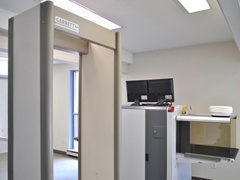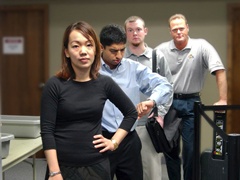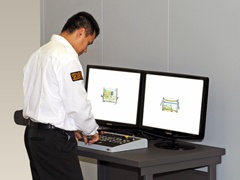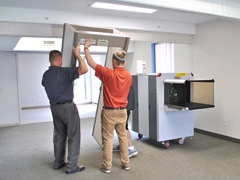 Security checkpoints exist as a measure of precaution to protect certain areas, only allowing specified individuals and items through the threshold. We’ve all experienced these points of inspection at least once in our lives. Many people tend to think of an airport security checkpoint, but it may also include checkpoints at secure buildings, government facilities, courthouses, correctional facilities, etc.
Security checkpoints exist as a measure of precaution to protect certain areas, only allowing specified individuals and items through the threshold. We’ve all experienced these points of inspection at least once in our lives. Many people tend to think of an airport security checkpoint, but it may also include checkpoints at secure buildings, government facilities, courthouses, correctional facilities, etc.
We often expect a smooth transition through the checkpoint, but many of us know from experience that this is not always the case. There are many bottlenecks that can occur including blockages caused by the public, staff, and current process.
Typical Screening Methods
A typical checkpoint will screen people and their belongings. People screening or passenger screening will typically involve the use of millimeter wave technology, walk through metal detector (WTMD), hand held metal detector (HHMD), pat-down, and/or explosives trace detection (ETD). The screening of personal belongings will typically involve use of an X-ray system, hand search, and/or ETD unit. Any combination of these methodologies may be used at a particular security checkpoint, depending on the industry and screening needs.
Bottleneck 1: The Public
 One bottleneck in checkpoint screening can arise from the individuals passing through. It can certainly be an intimidating process and people who do not pass through frequently may need more direction on what to do and where to go. Elderly folks and families with children usually require more time to get through and gather their belongings at the other end.
One bottleneck in checkpoint screening can arise from the individuals passing through. It can certainly be an intimidating process and people who do not pass through frequently may need more direction on what to do and where to go. Elderly folks and families with children usually require more time to get through and gather their belongings at the other end.
At times there may be disruptive, uncooperative individuals who purposefully slowdown the lane’s momentum and make it difficult for staff to perform their duties. If a person is absolutely noncompliant, an escort may be required which causes further delays.
Whether deliberate or unintentional, some individuals may be in possession of contraband or a prohibited item. If these are discovered, it will delay or even halt screening operations depending on the severity of the find. Threat items such as loaded guns or anything resembling explosive devices (even if they are just novelty toys or replicas) are sure to shut down operations for an extended period of time.
Bottleneck 2: The Staff
 Staff can also be the source of a bottleneck. Staff should only be placed at the checkpoint after a sufficient amount of training has been logged. Feeling uncomfortable with performing certain tasks or uneasiness with the constant pressure of the environment is sure to cause slowdowns.
Staff can also be the source of a bottleneck. Staff should only be placed at the checkpoint after a sufficient amount of training has been logged. Feeling uncomfortable with performing certain tasks or uneasiness with the constant pressure of the environment is sure to cause slowdowns.
Security personnel must be confident, quick, and proficient at X-ray interpretation, performing ETD functions, using all screening equipment, conducting hand searches, and whatever else is needed at that particular checkpoint. In addition, all personnel must communicate and work efficiently with one another in order to have a successful security checkpoint.
Many companies employing security screeners have recurrent training programs in place to refresh staff every six months or on an annual basis. Those with X-ray interpretation responsibilities may be required to train on a simulator more often than that to hone their skills.
Bottleneck 3: The Process
 Lastly, the screening process in place may also cause bottlenecks. An improper configuration of equipment and screening stations will result in inefficiencies. The transition through the checkpoint must flow properly and be as seamless as possible to avoid hang-ups.
Lastly, the screening process in place may also cause bottlenecks. An improper configuration of equipment and screening stations will result in inefficiencies. The transition through the checkpoint must flow properly and be as seamless as possible to avoid hang-ups.
If a secondary check is required such as a pat-down or bag search, these activities should be redirected to an area off the main lane. If they are not diverted, the rest of the lane is brought to a standstill until the issue is resolved.
Some companies are using automated systems to relieve bottlenecks. Divesture trays that have been X-rayed but require secondary screening are automatically redirected to a separate area where it may undergo a second look under X-ray or a physical search. Automated systems can also send empty bins back to the front of the lane so they can be reused. This is particularly helpful since there will never be a shortage of bins and staff can redirect their attention elsewhere.
Conclusion
Of course it is not possible to control every aspect of the security checkpoint, but whatever can be done upfront to minimize bottlenecks in an operational setting should be done. This includes ensuring employees have received sufficient training with all aspects of the checkpoint and certifying the flow of stations and screening processes are seamless. This will alleviate some tension related to bottlenecks at a typical security checkpoint.
What are some other security checkpoint bottlenecks you have encountered? Let us know your thoughts below.
